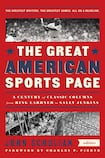
Joe Palmer, one-time horse racing correspondent of the New York Herald Tribune, once wrote: “All men are equal on the turf or under it”. Here, in a nutshell, Palmer gave us the essence of this sport and why it persists.
When it comes to sports writers some are more equal than others; a class Palmer sits comfortably in upon reading him. He’s one of the standout names in this enjoyable and entertaining collection of classic American sports columns. Anyone longing for the disappearing age of the cut-out-and-keep sports writer will find plenty to cherish here (Many have been squeezed from press boxes by either budget cuts, or the plethora of ex-pros pushing their way in, not content with their healthy bank balances and bulging trophy collections).
The Great American Sports Page can sit ringside alongside other heavyweight Library of America (LOA) publications on AJ Liebling, Red Smith, and WC Heinz. In 2011, LOA also released the essential boxing anthology At The Fights, edited by John Schulian and the late, great, much missed George Kimball, formerly of this parish. Schulian does an admirable job as editor here again.
He makes so many fine shot selections, allowing the writers to bolt from any journalistic trenches towards the leafy uplands of the literary. He courageously spreads his bets as editor, too: from bankers in World Series, Super Bowls, and prize fights, to outliers of tennis, motor racing, and Gertrude Ederle attempting to swim the English Channel in 1926. I doff my cap to Jerry Izenberg in particular, in taking his perennially exquisite pen into the world of rodeo bull-riding and making the reader hold tight to the end.
Schulian notes that there were nominally two camps in early American sports columns – the Gee-Whiz and Aw-Nuts Brigades
The book allows a reader trace the evolution of sports writing: the change in writerly styles and journalistic attitudes, or new ground broken by the likes of Frank Graham, who in the 1930s began going into dugouts and dressingrooms and recreating in his columns what had been said by players and management. Red Smith rightly saw this step as “the most important single change in my business in my lifetime”.
Schulian notes that there were nominally two camps in early American sports columns – the Gee-Whiz and Aw-Nuts Brigades. Both feature in this collection, but the overall tone of the book feels right and balanced. There’s no “godding up” of athletes, to use the memorable decree of Herald Tribune sports editor Stanley Woodward. In fact, the only bum note I found was Grantland Rice, but Schulian concedes as much from the toss, writing in Rice’s biographical snapshot that the writer: “seemed to see every event he covered as the equivalent of the Trojan War”. For that fact alone Rice is worth encountering.
Schulian also points out that it wasn’t until the late 1970s that “women began making America’s leading sports pages better with their intellect, empathy, courage, wit, and enviable prose styles”. Diane Shah, Jane Leavy, and my long-time favourite Sally Jenkins rightly take their places at this top table. Leavy has one of the outstanding pieces from her time spent with baseball legend Mickey Mantle; he with the beautiful sing-song name, who was no longer swingin’ when Leavy wrote her profile, which makes it all the more fascinating.
In his introduction Schulian has a good cut at today’s unfairly weighted environment for sports journalism: “Then came the train wreck that scrambled daily sports writing, probably forever. Sports went corporate, athletes made too much money not to toe the party line, and PR honks swarmed around interviews like plant lice. The internet’s sometimes nonsensical demand for immediacy sapped weary writers’ energy for art.”
‘Perfect record’
In The Great American Sports Page you will find art; you will also find: winking wry humour (Damon Runyon, Ring Lardner, Jim Murray); busted-nose prose poems in the shape of Jimmy Cannon; Wendell Smith’s social history embodied in a dignified and graceful Jackie Robinson; Death of a Racehorse by Heinz, which remains the “perfect record” of sports writing, and, for this reader anyway, has a contained and controlled emotional depth similar to George Orwell’s essay Shooting an Elephant.
The collection, naturally, has many unforgettable lines that a reader/writer will hope to pass off as his own some day: (“The image of Vince Lombardi in mid-fury in Green Bay was so terrifying it appeared for a moment the officials were going to cede him the island of Sicily as a gesture of conciliation” – Jim Klobuchar). There’s the life-leaping light sports can bring in the shadows of mortality with Jenkins and Dick Young; Larry Merchant pitching up with poet Marianne Moore to talk baseball. Meanwhile, Bill Plaschke will stop you in your tracks with his sole contribution, and if he doesn’t have you choking up with emotion by the final sentence, then don’t go swimming, for your heart will sink you.
I could go on, but I won’t; never take too much out of the ball. If sports equals life – and vice-versa – to you, or someone you know, buy this collection. It’s a big ball of fun.












